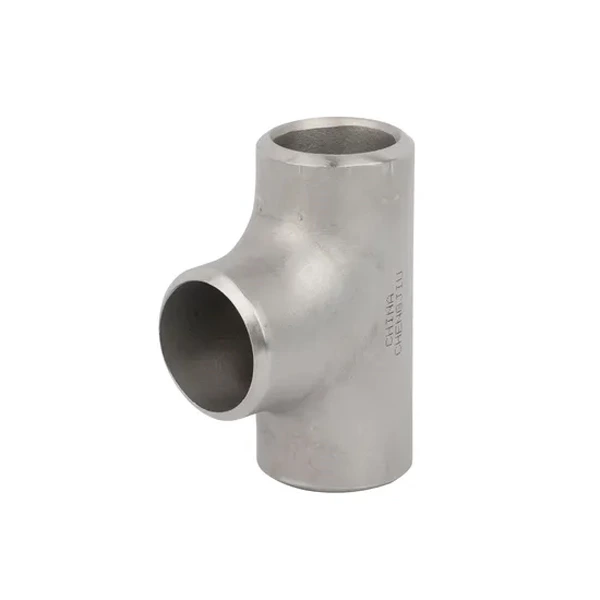Stainless Steel Tee Design And Materials: What You Need To Know
In industrial piping systems, stainless steel tee are widely used in the chemical, petroleum, power, and other critical industries due to their excellent corrosion resistance and stability. As a key component in pipeline connections, stainless steel tees ensure smooth fluid flow in piping systems, ensuring safe and efficient production processes. Professional researchers point out that "the design and material selection of stainless steel tees have a crucial impact on the performance of industrial pipelines, especially when exposed to high temperatures, high pressures, and corrosive environments. Choosing the right material and design is crucial."
Structure and Main Components of Stainless Steel Tees
A stainless steel reducing tee consists of three main parts: a pipe joint, an outer protective layer, and an internal distribution channel. The pipe joint connects to the pipe and is typically welded or threaded to ensure a tight seal and pressure-bearing capacity. The outer protective layer is made of stainless steel and undergoes surface treatment to enhance its corrosion resistance. The internal distribution channel, the core of the tee, distributes the fluid and is typically designed in T- or Y-shaped configurations to accommodate different fluid flow requirements. Experts say, "The design of a stainless steel tee must take into account the pressure, temperature, and corrosive environment of the fluid to ensure long-term stable operation."
Types of Stainless Steel Tee Designs
3 4 stainless tee come in a variety of designs depending on the application requirements. Common types include T-shaped, Y-shaped, and L-shaped tees. T-shaped tees are widely used for fluid distribution and convergence and are suitable for most general applications. Y-shaped tees are suitable for environments requiring high flow rates and low fluid resistance, effectively reducing pressure loss during fluid flow. L-shaped tees are often used at pipe bends to ensure smooth fluid flow. The most suitable design is selected based on the specific fluid transport needs.
How do stainless steel tees work?
Design Advantages: Stainless steel tees utilize a design that conforms to fluid dynamics, enabling smooth fluid distribution to multiple pipes and reducing pressure loss during flow.
Functional Uniqueness: Their core function is to distribute or converge fluids as needed, making them widely used in industries such as the chemical and petroleum industries.
Advantages: Made of stainless steel, they can withstand long-term use in harsh environments, such as high temperatures and acidic and alkaline media, and exhibit strong corrosion resistance.
Disadvantages: Although 1 stainless steel tee are highly corrosion-resistant, they can experience material fatigue over time under high temperatures and high pressures, leading to degradation and leakage at pipe joints. Therefore, regular inspection and replacement are necessary. In summary, the operating efficiency of stainless steel tees is closely related to material selection and design rationality, providing important guarantees for the stable operation of industrial systems.
Different Stainless Steel Tee Designs
3 4 stainless steel tee are primarily designed based on their shape: T-type, Y-type, and L-type. The T-type design is commonly used for fluid distribution, boasting a simple structure and suitable for general industrial applications. The Y-type design is more suitable for high flow requirements, effectively reducing fluid flow resistance and improving pipeline efficiency. The L-type design is often used at pipe corners, ensuring smooth turns and avoiding severe fluid impact.
Different Stainless Steel Tee Materials
304 Stainless Steel: 304 stainless steel offers excellent corrosion resistance and is suitable for general industrial environments. It performs well in moderate temperatures and in common acidic and alkaline environments.
316 Stainless Steel: 316 stainless steel contains molybdenum, effectively resisting chloride corrosion and suitable for highly corrosive environments such as seawater and chemicals. 316 stainless steel offers increased strength and corrosion resistance, making it particularly popular in the chemical and petroleum industries.
321 Stainless Steel: 321 stainless steel contains titanium, offering excellent high-temperature resistance and is commonly used in piping systems operating in high-temperature environments. It is widely used in industries such as petrochemicals and power generation, maintaining excellent stability and oxidation resistance at elevated temperatures.
Huahao: Stainless Steel Tee Manufacturer
Huahao is a professional manufacturer of stainless steel tee fittings, dedicated to providing high-quality pipe connection solutions to customers worldwide. As a leading company in the industry, Huahao utilizes advanced production equipment and a strict quality control system to ensure that every product meets international standards. Whether in T-, Y-, or L-shaped designs, Huahao offers customized products tailored to customer needs. These products are widely used in industries such as petroleum, chemical, power generation, and pharmaceuticals. With years of production experience and accumulated technical expertise, Huahao consistently upholds the principles of innovation and quality, earning high praise from customers worldwide.
FAQ
What high-temperature and high-pressure environments can stainless steel tees withstand?
1 2 stainless steel tee are suitable for most high-temperature and high-pressure environments, especially 316 stainless steel tees, which can withstand long-term use in seawater and chemical environments.
How can I ensure the long-term stability of a stainless steel tee?
Regularly check the welding joints and pipe connections and replace aging parts in time to extend the service life of the stainless steel tee.
